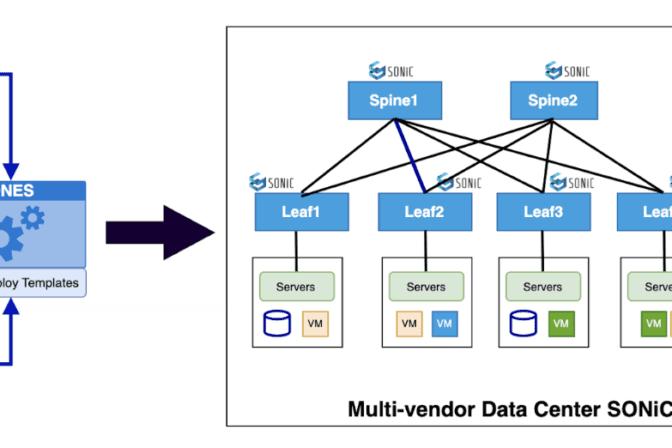We, at Aviz Networks, are dedicated to continuously optimizing processes, strengthening your SONiC network, and bringing the best version of our every service at your fingertips.
Moving a step ahead in our journey, we are thrilled to announce the release of ONES 1.3. This latest version is armed with advanced features, specially designed to enhance your orchestration and Day 2 operations experience. Here’s an article by our Fabric Manager Team that deep dives into the remarkable additions and benefits of ONES 1.3.
Redefining Network Redundancy with EVPN Multihoming
EVPN Multihoming (EVPN MH) stands out as our star feature in ONES 1.3. Its cutting-edge technology takes over from the traditional Multi-Chassis Link Aggregation Group (MC-LAG) setup—offering a new paradigm in terms of server redundancy, high availability, load balancing, and scalability. EVPN MH brings in a level of resilience that ensures your SONiC network remains operational even in the face of failures. With its increased bandwidth and scalability, it’s a game changer for organizations aiming to optimize their network infrastructure.
Maximizing Reliability with L2/L3 Vxlan EVPN
While EVPN Multihoming is a critical addition, ONES 1.3 also builds upon the solid foundation laid by its predecessor. Features like L2 VxLAN (Asymmetric IRB) and L3 VxLAN (Symmetric IRB) – initially introduced in ONES 1.2 – power up your SONiC network fabric with enhanced reliability through mechanisms like MC-LAG and EVPN MH. These features seamlessly integrate into your network architecture to create a robust fabric that ensures your data center operations run smoothly and efficiently.

Deployment Verification Status in ONES Configurations Page
Safeguarding Your Configuration with Backup and Restore
Besides focusing on advanced networking, ONES 1.3 also addresses the critical need for configuration management. Its new Config Backup and Restore feature empowers users to take proactive measures in securing their network configurations. They now get the option to create backups of their device configurations within the fabric. This provides a safety net, allowing every user to confidently experiment with configurations while having the flexibility to restore to the previous state in case anything goes awry.

Restore Configuration in ONES
Unlock Automation Potential with ONES API Support
Our latest version brings automation to the forefront by introducing comprehensive API support. All orchestration and management functionalities are seamlessly integrated into the ONES user interface through APIs. This not only enhances the user experience but also allows you to harness the power of automation in your data center operations. A wide range of APIs, including uploadDay1Config, getDay1ConfigStatus, rebootRequest, upgradeNOSImage, and more, are at your disposal—enabling you to streamline and expedite various tasks.
Here’s a glimpse of the APIs at your fingertips:
- uploadDay1Config: Enables intent-driven orchestration that performs Day 1 fabric orchestration for various data center topologies. This method initiates the Day 1 orchestration depending on the topology and intent supplied via a template file. This REST API allows network operators to upload an entire intent file (yaml-based) and orchestrate the entire fabric in a desired intent-based underlay and overlay.
- getDay1ConfigStatus: Retrieves Intent Status after provisioning over SONiC-enabled fabric devices
- rebootRequest: Initiates device reboots seamlessly
- upgradeNOSImage: Performs custom NOS image upgrades for the specific devices
- enableZTPUpgrade: Triggers ZTP image upgrades
- getImgmgmtStatus: Verifies image upgrade progress
- getConfigDiff: Compares current and last orchestrated config states
- getIntentDerivationLogs: Accesses insightful host logs information
- backupConfig: Safeguards device configurations through backup
- restoreConfig: Easily restores device configurations
- configsListToRestore: Views available backups for a specific device
- status: Retrieves deployment status logs
Day 2 Operations API: Streamline NetOps
The ONES 1.3 release also revolutionizes Day 2 operations with the introduction of the innovative replaceConfig API. This API provides a contextual diff between the current running configuration of a device and a given golden configuration file. With this insight, users can meticulously examine the differences and proceed to apply the desired changes to the device. Most importantly, the system gracefully rolls back to the base configuration of the device and ensures operational stability in case there is any issue during the application process.
Auto-Discovery
Auto-discovery capability of ONES discovers SONiC devices over a secure channel and automatically collects network state data using streaming telemetry providing drill down insights including Inventory, platform & system health, control & data plane utilization and compliance.
We are proud to share that ONES 1.3 is a testament to the evolution of our SONiC network management and orchestration. With groundbreaking features like EVPN Multihoming, Config Backup and Restore, extensive API support, and the Day 2 Operations API—network administrators and IT teams can seamlessly streamline their operations, enhance reliability, and embrace the power of automation. This release reaffirms Aviz Networks’ commitment to delivering cutting-edge solutions that empower organizations to achieve operational excellence in their data centers. Together, let’s witness the future of network orchestration and management first-hand
For more information about ONES 1.3 and other Aviz Networks products, please visit https://aviznetworks.com/
To explore ONES 1.3 in action and get hands-on experience with the hardware of your choice, schedule your demo at https://aviznetworks.com/one-center
Author: Tarun Kumar Polanki, Sr Solution Engineer






